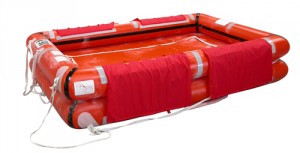
Fishermen in Southeast Alaska are learning about new safety requirements for life rafts that take effect later this month. The changes are included in past Coast Guard re-authorization bills and will mean smaller fishing boats will have to have a life raft to go three miles offshore.
Coast Guard commercial fishing vessel examiners were in Petersburg this month offering free dockside exams for boats getting ready to go out in a variety of fisheries this month and next.
The examiners held a question and answer session to brief fishermen on new requirements and spent a good part of their time answering questions about the new life raft requirement for smaller fishing boats.
Starting February 26, boats under 36 feet will be required to carry an inflatable life raft to go more than three miles offshore. Most fishing boats in the region, even the smaller ones, usually run more than three miles off the coast of Southeast Alaska’s islands, even if they’re staying on the inside waters.
Jim Paul, the Coast Guard’s fishing vessel examiner in Ketchikan thought the change was going to impact Alaska’s fishing fleet more than anywhere else in the U.S.
“Cause most of the other ones when they go more than three miles, they drive straight out, they’re right into the ocean, so they already gotta have these rafts,” Paul said. “We’ve got lots and lots of buoyant apparatus that the rest of the United States isn’t fooling around with.”
Paul thought a good portion of the troll fleet could be impacted by the new requirement. That’s potentially hundreds of permit holders who are out fishing now for winter king salmon and will need to have a life raft onboard after before the end of the month.
“What’s the cheapest raft you can buy?” asked fisherman Dave Rojcewicz.
“Good question,” Paul responded. “I don’t know. The prices, you’ll have to shop because of brand. But there’s two styles. Everybody thinks you have to have a hard canister raft. You don’t. An inflatable buoyant apparatus or coastal raft can be readily accessible and they got em in what looks like a red duffel bag, it’s called a valise pack. So you can carry it and just put it in there. For your smaller boats you can throw it in with your immersion suits and that could be it. So it doesn’t have to be a hard… And those are cheaper. For one you don’t have any equipment in em.”
Fishermen and the examiners agreed a new Inflatable Bouyant Apparatus, which is the name for the basic inflatable lift raft, could cost around $1700 to two thousand dollars. After the first two years, the rafts have to be returned to the manufacturer, tested and repacked, that’s an additional annual cost.
Fishermen were concerned with the lag time for ordering new survival equipment and thought they wouldn’t be able to get life rafts soon enough for the February 26 deadline. Paul thought there could be a way around that. “And there may be a way we just write you a, you give us proof that you ordered it and we can probably give you a letter saying based on supply and demand, you get a 60-day stay,” he said.
Smaller boats that don’t have the required raft after February 26th could be sent home from the fishing grounds with a fine to pay.
“And fines for commercial vessels are steep,” said Steve Ramp, a vessel examiner based in Sitka. “I dealt with a customer in Sitka last week. He had an 8000 potential civil penalty on his letter for lack of a survival suit. I’ve never seen one for under 2500 dollars. It’s not like mom and pop in the whaler out jigging up a halibut and forgetting one life jacket you get a 25 dollar ticket. Commerical mariners are treated more severly.”
The examiners said the most common trip termination they see is for vessels that don’t have a life raft or enough survival suits. Fishermen can have the fine waived after a violation by getting a dockside exam with the proper equipment.
Fisherman Eric Grundberg questioned the additional yearly cost that comes with having a raft.
“I’ve always had a life raft, always have one, that makes sense. Why when you buy a new life raft is it two years then you have to repack em every year? Why cant we saran wrap em and make it five years? Why cant we make em waterproof? Why do the ex-Coast Guard guys have to make money off us repacking rafts every year?”
Grundberg said former Coast Guardsmen worked for the companies making and packing survival gear and he joked about starting up that industry in Southeast Alaska.
Examiner Steve Ramp said it came down to law.
“The law reads you have to maintain your flares, you have to maintain your life raft in accordance with the manufacturers instructions,” Ramp said. “The Coast Guard doesn’t say you have to send your raft in after two years then every year. The raft manufacturer says and the law says you have to do what the manufacturer says. So it’s not the Coast Guard driving that train.”
Boats larger than 36 feet are already required to carry a type of larger inflatable life ring. That will have to be upgraded to a raft, but not until later this year. Also in the past, the Coast Guard in Juneau has issued an exemption letter for boats that have carried a skiff or inflatable zodiac instead of a Coast Guard approved inflatable life raft. That won’t be an option for boats going offshore later this year.
Joe Viechnicki is a reporter at KFSK in Petersburg.




